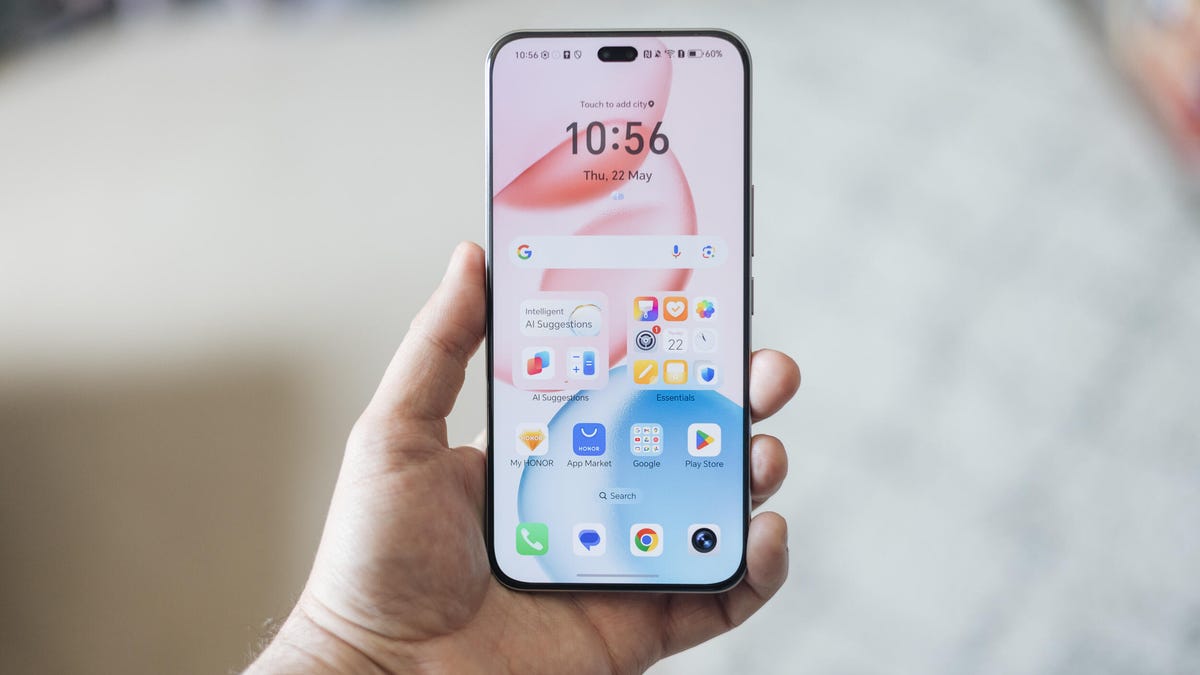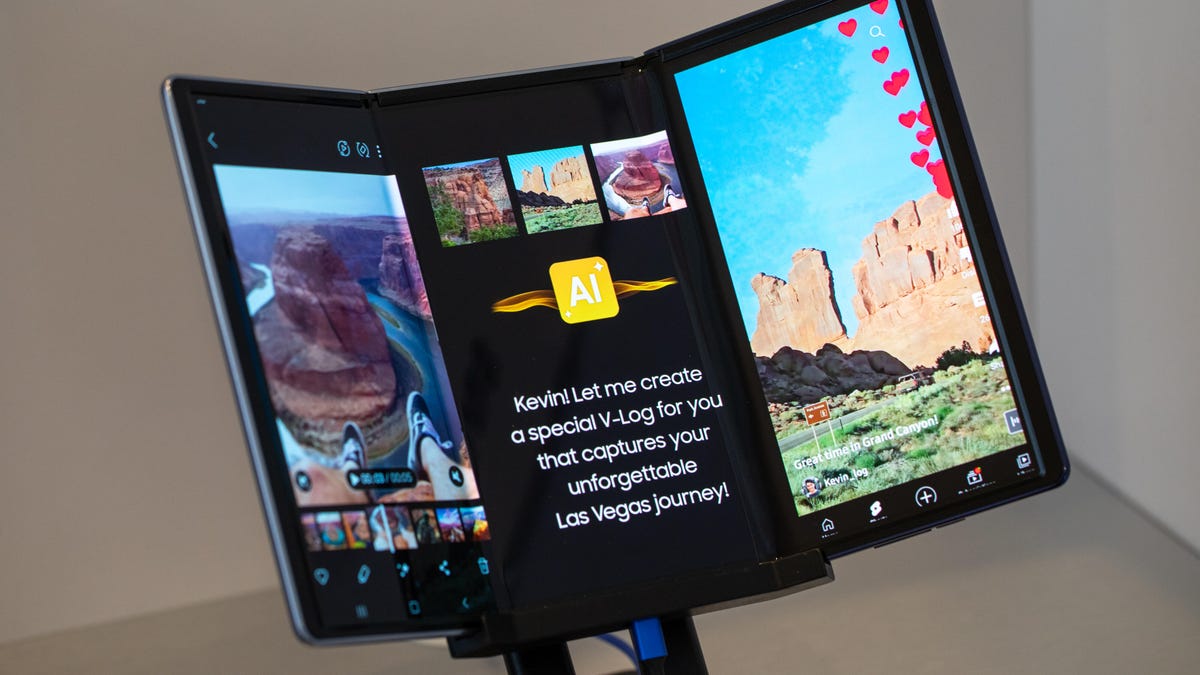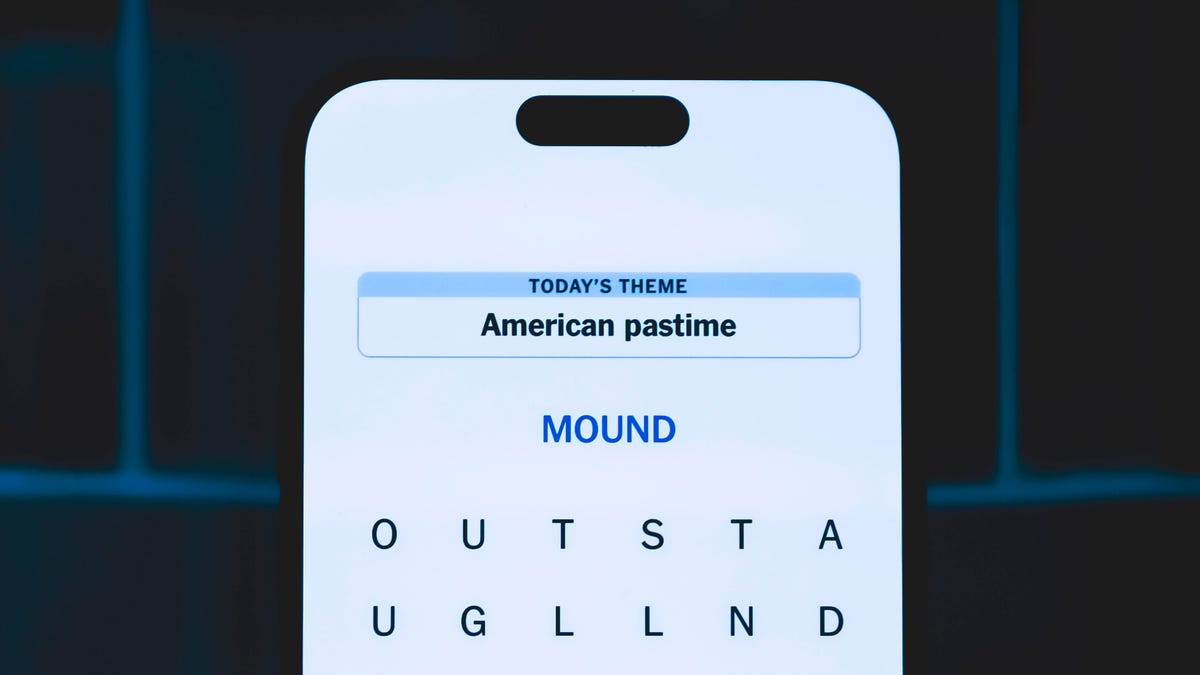Technologies
I Tested the Honor 400 Pro Phone and This Feature Blew My Mind
Review: The phone is packed with great tech but it’s the AI skills that really surprised me

The Honor 400 Pro phone stood out to me for one big reason during my testing time. It has an AI-powered tool that turns still images into moving video clips. The AI created videos felt at times like magic and took me on an emotional journey that I didn’t expect. But this phone has plenty going for it beyond its AI skills.
Its screen is bright and vibrant, it’s packed with power and at £700 in the UK, it’s relatively affordable and offers some serious competition to both Samsung’s $650 Galaxy S24 FE and arguably even Google’s $1,000 Pixel 9 Pro. The downside for many of you is that the Honor 400 Pro won’t be officially on sale in the US. And that’s a pity because at a time when nearly every phone release comes with AI features (most of which feel like gimmicks), Honor proves that it’s possible for phone AI to really capture your attention. The 400 Pro’s £700 price converts to $938.
There’s also the base Honor 400, which uses a lower-end processor, has a smaller display but still packs the same AI skills. It’ll cost only £400 in the UK, or $537, converted.
I’ve been testing the phone for the past week so here’s what’s good — and not so good — about the Honor 400 Pro.
A vibrant screen, plenty of power
The 400 Pro has a 6.7-inch screen that offers tons of room to do your favorite mobile games or YouTube videos justice. It’s bright enough to counter midday sun and its colors are vibrant. It’s got a maximum 120Hz refresh rate, which makes scrolling around look nice and smooth.
The phone runs on a Qualcomm Snapdragon 8 Gen 3 processor that was a mainstay on most 2024 flagship Android phones and which put in some decent scores on our benchmark tests, considering the price. Its scores are in line with last year’s Galaxy S24 and Xiaomi 14 Ultra, which is no surprise as all three phones use the same chip. It’s got more than enough power to handle all of your everyday needs while tackling demanding games like Genshin Impact and PUBG at max settings without breaking a sweat.
Navigating around the Android 15 interface is a breeze. Honor’s skin of the UI is pretty standard, though I’m irked by the number of preinstalled apps the phone comes with. Temu, TikTok, LinkedIn, Booking.com, Amazon and something called ReelShort are all on the phone — along with various others — as soon as you turn it on making it feel quite cluttered from the off. I get that Honor probably makes a healthy bit of cash from these companies by forcing their apps on customers by default, but I’d like to see the phone be even cheaper given that it’s essentially ad-supported. You can uninstall these apps and I advise you to have an immediate clear-out once you get it out of the box.
Honor says the phone will receive six years of software and security support, which is quite good, though it’s a year behind the seven years of security support offered by both Samsung and Google. I’d like to see Honor (and other mobile companies) continue to battle to see who can support their phones for longer — it’s better for your wallet and it’s better for the planet.
AI. Lots of AI
No phone worth its salt in 2025 would launch without some form of AI, and the Honor 400 Pro is no exception. You’ll find a variety of the usual AI tools that range from a speech-to-text tool that transcribes dialogue in real time and a real-time language translation tool to a function that can rephrase, expand or summarise blocks of text.
Most of these are things you’ll find on most AI-enabled phones these days. They work about as well as the ones I’ve tried elsewhere. Google’s Gemini Advanced is also built in, another standard part of the Android experience.
The one feature that took me by surprise though was the image to video tool which creates a 5-second video out of a photo you provide. It’s simple: Open the Image to Video tool in the gallery, choose your source image from your camera roll and hit go. It takes around a minute but then you’ll be presented with an animated version of your still photo.
It uses Google’s VEO-2 AI model, and it seems essentially random in how it decides to bring your image to life as there are no options to provide prompts in what you want to see. Some results are quite bland while others have a lot more going on. The results can be hit and miss in their quality but it’s fun to play around with, though it’s arguably pointless beyond the sheer novelty of it. That said, I was conflicted when I fed it an image of my dad who died when I was a young child.
Right now the tool is available as part of a «free trial» although Honor has yet to confirm how long this trial lasts or how much it will eventually cost. AI is clearly a big part of the phone and while you can use it without using any of the AI tools, it feels like you’d be missing out on a big part of the equation if you chose to.
Hit and miss cameras, middling battery
On the back is a triple camera setup consisting of a 200-megapixel main camera (yes, I did mean to put two zeroes there), a 50-megapixel telephoto camera and a 12-megapixel ultrawide camera. Shots from all three cameras can look solid, with decent overall exposure (if sometimes a little on the bright side for my taste) and plenty of detail. I say «can» as while I have taken plenty of good images with the phone, I’ve also taken various ones that have disappointed me.
The 6x telephoto camera seems to struggle with exposure at times, with blown-out highlights visible in multiple test images I took. It doesn’t happen all the time though and there have been various occasions in my testing when its results look great. I can best describe it as «hit and miss.»
The cameras certainly aren’t the best around — you’ll need to splash more cash for the S25 Ultra or the iPhone 16 Pro if you want that — but they’re good enough for those of you looking for quick snaps on your travels to share with family and friends over WhatsApp or Instagram.
Inside the phone is a 5,300-mAh battery which should see you through most of a day of mixed use. It didn’t do great on our demanding battery drain test, but I’ve certainly seen worse. It does support 100W wired charging though so getting the juice back in is a speedy business.
Honor 400 Pro: Is it worth buying?
The phone’s vibrant display, powerful processor and solid camera setup make it a decent overall option if you’re looking for a phone that’s more affordable than today’s flagships. The AI skills are the cherry on the top, especially the image to video tool which I found genuinely fascinating to use. Will the novelty wear off? Yes, absolutely, but it’s certainly fun to play with for a while.
Technologies
Samsung’s Wild-Looking Tri-Fold Phone Debuts at APEC Summit in South Korea
The Galaxy phonemaker showed off a twin-hinged foldable at a Korean consumer tech show.

Samsung unveiled its first triple-display foldable phone for consumers at a tech exhibition hall during the APEC CEO Summit in South Korea. The Korean publication Dailian reported that the new phone will launch in November or December.
The tri-fold phone, which doesn’t have an official name yet, was revealed as a prototype on display. Whereas the Galaxy Z Fold 7 and Galaxy Z Flip 7 fold in half along one hinge, Samsung’s next device folds in two places to be as compact as a typical smartphone with a 6.5-inch outer screen, then unfolds for a tablet-size 10-inch screen, according to The Chosun Daily. Compare that with dual-screen foldables that have inner screens measuring approximately 8 inches. The Z Fold 7 has a single crease on its main screen; the new tri-fold could have two creases.
Samsung has been at the forefront of foldable phones since releasing the first Galaxy Fold in 2019 and the Galaxy Z Flip in 2020. At the time, it faced fierce competition from Motorola and Huawei — the latter of which gained a significant lead in 2024 with its own tri-fold Huawei Mate XT, which was followed by a second version. Samsung’s launch of its own competitor keeps the company in the game.
Here’s your first look at the Samsung Galaxy Z TriFold.
Screen when folded: 6.5-inch
Screen when unfolded: 10-inch
It might be announced later this week.
Source: Chosun Media pic.twitter.com/EhT4i1hW2k— Trakin Tech English (@trakinenglish) October 28, 2025
These two consumer tri-folds have their differences. The Huawei Mate XT’s two hinges fold in opposite directions like an accordion, giving it a Z shape, while Samsung’s device has two screens that fold inward in what Dailian (through Google Translate) asserts is «G-shaped.» Given that Samsung has branded its foldable line as the Z-series, it’s ironic that the company didn’t adopt that shape and format for its tri-fold.
Samsung didn’t release any more details about its tri-fold, though Dailian expects it to be even pricier than the Galaxy Z Fold 7, which starts at $2,000in the US. From photos of the device — apparently a prototype — behind glass, you can see a front-facing camera on the inner display (when unfolded) and outer screen (when folded up). But since Samsung also didn’t show the device folding, there are a lot of questions about its durability and capability before its supposed launch in a month or two.
It’s not a total surprise to see Samsung’s tri-fold ready to go. For years, the company has displayed various flexible display designs, including three-screen formats, during CES. In the last few months, there’s been a steady flow of rumors and outright executive confirmations that Samsung was gearing up to unveil its tri-fold. Now we’ll have to see whether the company that’s fought so hard to be at the forefront of smartphone design can release another format that dominates the folding phone niche — all before one of its biggest rivals, Apple, even releases its first foldable.
Samsung didn’t respond to a request for comment.
Technologies
Be Wary of AI Videos as Hurricane Melissa Hits Jamaica. How to Spot a Fake
AI-generated storm videos are spreading rapidly online. Here’s where to find reliable information.

As Category 5 Hurricane Melissa bears down on Jamaica with winds topping 180 mph, social media is being hit by a surge of AI-generated and misleading videos, showing catastrophic flooding, collapsing buildings and rescue scenes that never happened.
Across X, TikTok, Instagram, WhatsApp and other social media platforms, fake clips spread quickly, racking up millions of views in hours. Many of these videos are spliced footage from past storms or clips created entirely with text-to-video AI tools.
In times of crisis, like a dangerous and imminent natural disaster, these fake videos can create confusion, panic and distraction at a time when accuracy can be life-saving.
Natural disasters have always bred rumors and recycled footage, but the rise of AI-generated video has supercharged the problem. Tools like OpenAI’s Sora and other AI-video platforms can render realistic-looking images of storms, floods and damage scenes in seconds, reaching millions online in just a few hours.
Read also: The Deepfakes Are Winning. How Can You Tell if a Video Is Real or Sora AI?
Don’t miss any of our unbiased tech content and lab-based reviews. Add CNET as a preferred Google source.
Why storms are a magnet for fake news
Storms are visual, emotional and fast-moving, which is the perfect recipe for viral misinformation. In years past, videos were often taken out of context or labeled as a different storm. Now, they can be digitally fabricated from scratch.
Some depict apocalyptic flooding that hasn’t occurred, while others claim to show «real-time» conditions hours before landfall. Several videos that have circled this week include images of sharks swimming in the storm surge and unsettling depictions of human suffering.
False videos like these can exaggerate the danger of the storm, create panic, undermine trust and distract emergency responders, as misinformation pulls attention from verified reports.
The following three videos are all fake. They are labeled (albeit briefly) with the Sora watermark, which indicates they were made in OpenAI’s video generator.
How to separate truth from fiction online
When social feeds fill with dramatic hurricane clips, it’s important to separate truth from fiction.
«You have to be very discerning,» Senator Dana Morris Dixon, Jamaica’s information minister, said. «You have to know what is good information from bad information. If you want to know where the storm is going, if you want to know what to do, you need to look for official sources.»
Dixon highlighted that the Jamaica Information Service, Office of Disaster Preparedness and Emergency Management’s information sites and the Office of the Prime Minister page are resources for legitimate, timely updates.
Here are some ways to be discerning.
Check the source. If the video comes from an unfamiliar account, lacks a timestamp or carries no recognizable media branding, assume it is fake until verified. Also, look for the Sora watermark indicating it was made in OpenAI’s app, or read the comments to see if someone else has flagged the video as fake.
Ask yourself if it’s new and local. Does the geography match Jamaica? Is the footage recent? Many «Melissa» clips could actually be from past Caribbean or Gulf storms.
Cross-check before believing. Confirm through trusted outlets, like the Meteorological Service of Jamaica and the US National Hurricane Center, or established media like the BBC, Reuters or the Associated Press.
Pause before sharing. A viral video can cause harm if it spreads misinformation. Wait until a credible source verifies it before reposting.
Go local. If you’re in the affected area, rely on local emergency agencies, radio stations and city or county-level officials for evacuation and safety updates.
Monitor official alerts. For real-time instructions, stick with government channels and local emergency feeds. Your safety depends on accurate information, not viral content.
As AI-generated media becomes easier to produce, hurricanes like Melissa offer a preview of a new reality: one in which you can’t trust much of the information you see online.
Staying safe means being skeptical and diligent when looking for accurate and even lifesaving news.
Read also: What Is AI Slop? Everything to Know About the Terrible Content Taking Over the Internet
Technologies
Today’s NYT Strands Hints, Answers and Help for Oct. 29 #605
Here are hints and answers for the NYT Strands puzzle for Oct. 29, No. 605.

Looking for the most recent Strands answer? Click here for our daily Strands hints, as well as our daily answers and hints for The New York Times Mini Crossword, Wordle, Connections and Connections: Sports Edition puzzles.
Today’s NYT Strands puzzle is a fun one for English majors. Some of the answers are a bit tough to unscramble, so if you need hints and answers, read on.
I go into depth about the rules for Strands in this story.
If you’re looking for today’s Wordle, Connections and Mini Crossword answers, you can visit CNET’s NYT puzzle hints page.
Read more: NYT Connections Turns 1: These Are the 5 Toughest Puzzles So Far
Hint for today’s Strands puzzle
Today’s Strands theme is: «Nevermore!»
If that doesn’t help you, here’s a clue: Poem by Edgar Allen Poe.
Clue words to unlock in-game hints
Your goal is to find hidden words that fit the puzzle’s theme. If you’re stuck, find any words you can. Every time you find three words of four letters or more, Strands will reveal one of the theme words. These are the words I used to get those hints but any words of four or more letters that you find will work:
- MOVE, RAVE, NOVEL, BACK, LACK, HACK, FEAT, HEAT, WING, SORE, ROSE, STAR, RATS
Answers for today’s Strands puzzle
These are the answers that tie into the theme. The goal of the puzzle is to find them all, including the spangram, a theme word that reaches from one side of the puzzle to the other. When you have all of them (I originally thought there were always eight but learned that the number can vary), every letter on the board will be used. Here are the nonspangram answers:
- BLACK, CLEVER, WINGED, FEATHERED, OMNIVOROUS
Today’s Strands spangram
Today’s Strands spangram is THATSSORAVEN. To find it, look for the T that’s six letters down on the far-left vertical row, and wind across.
-

 Technologies3 года ago
Technologies3 года agoTech Companies Need to Be Held Accountable for Security, Experts Say
-

 Technologies3 года ago
Technologies3 года agoBest Handheld Game Console in 2023
-

 Technologies3 года ago
Technologies3 года agoTighten Up Your VR Game With the Best Head Straps for Quest 2
-

 Technologies4 года ago
Technologies4 года agoVerum, Wickr and Threema: next generation secured messengers
-

 Technologies4 года ago
Technologies4 года agoBlack Friday 2021: The best deals on TVs, headphones, kitchenware, and more
-

 Technologies4 года ago
Technologies4 года agoGoogle to require vaccinations as Silicon Valley rethinks return-to-office policies
-

 Technologies4 года ago
Technologies4 года agoOlivia Harlan Dekker for Verum Messenger
-

 Technologies4 года ago
Technologies4 года agoiPhone 13 event: How to watch Apple’s big announcement tomorrow
